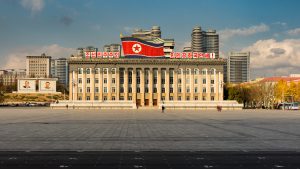After years of disruption from United Nations sanctions and the pandemic, North Korean exports to China surged through the first 11 months of 2023. However, North Korea’s export recovery is potentially fragile due to its dependence on a single export category.
Beginning with Resolution 2270 in 2016, the U.N. Security Council has passed a series of resolutions designed to sanction key sectors of North Korea’s international trade in response to Pyongyang’s increased rate of ballistic missile and nuclear weapons tests. Over time, these sanctions significantly curtailed North Korea’s legitimate export earnings. Exports to China, which accounts for more than 90 percent of North Korea’s trade, declined from $2.6 billion in 2016 to only $213.2 million in 2018.
North Korea’s decision to strictly control its border during the pandemic further depressed exports to China. In 2020, they fell to just $48 million and only grew to $58 million in 2021 despite global trade exceeding pre-pandemic levels. North Korean exports began to recover in 2022 as China and North Korea resumed trade via freight trains across the border and grew to $133.7 million, though still below pre-pandemic levels.
However, through November of this year, North Korea’s exports to China have already reached $267 million, exceeding the full year total in 2018 when U.N. sanctions were fully implemented. The figure through November is 133 percent higher than through the same period in 2022.
With North Korean exports to China averaging just under $27 million a month over the last six months, total exports for the year will likely end up just under $300 million.
While exports remain significantly below their pre-U.N. sanction level, Pyongyang has shown an ability to adapt in recent years. With exports such as coal and seafood under sanction, North Korea began to export items that previously were not part of its export mix. Watch movements, for example, surged from no exports in 2016 to $49.2 million in 2018 to become North Korea’s top export item shortly after sanctions were fully implemented. North Korea also switched to exporting non-sanctioned minerals such as tungsten and molybdenum that it had previously exported in lower volumes.
The current resurgence in North Korean exports is being driven almost entirely by a surge in exports of wigs, false beards, eyebrows, and lashes. These now account for 57 percent of North Korea’s exports to China, or $151.8 million in exports this year. They also account for 86 percent of China’s imports of these products.
This surge in exports, however, is built on a fragile basis. Prior to U.N. sanctions, exports of coal dominated North Korea’s export mix, but only accounted for 43 percent of exports at the time. Exports of wigs, false beards, eyebrows, and eyelashes take up a much larger percentage of North Korea’s exports today. The current level of exports of these products also significantly exceed previous levels. Exports in this category didn’t top $1 million until 2016, and the previous high was $31 million in exports in 2019.
This trade is also built on processing trade with China. So far this year, North Korea has imported $145 million in human hair, nearly as much in value as it has exported in wigs, false beards, eyebrows, and eyelashes. This could signal growing exports going forward, but also highlights how dependent North Korea is on China for what is now far and away its most important export. It also suggests that Pyongyang is likely earning little off this trade.
At the same time, North Korea has not seen a recovery in the export of watch movements, which through November were $3.4 million and only 1.27 percent of exports. In contrast, they accounted for 22 percent of exports in 2019. Exports of optical and photographic parts, sports equipment, and fishing equipment also remain severely depressed despite having grown after sanctions were put in place.
The only other significant exports for North Korea of more than $10 million are ferroalloys (alloys of iron and other minerals), tungsten, molybdenum, and electricity. Exports of ferroalloys are just above non-inflation adjusted highs at $30.7 million through November, and exports of electricity to China are up as well. However, exports of tungsten and molybdenum have declined this year.
On the surface North Korea is experiencing its strongest year of exports since U.N. sanctions were fully implemented in 2018. However, underneath the surface that surge in exports is being driven by a single export category, and one that may provide little financial benefit to North Korea. Should Pyongyang manage to restore exports in watch movements, toys, sports equipment, and fishing equipment to prior levels, and grow its non-sanctioned mineral exports there is ample room for North Korean exports to grow in 2024. However, that growth potential is also built on a fragile foundation that could as easily see exports decline next year.

































